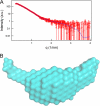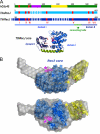Structural and functional insights into the DNA replication factor Cdc45 reveal an evolutionary relationship to the DHH family of phosphoesterases
- PMID: 22147708
- PMCID: PMC3281742
- DOI: 10.1074/jbc.M111.285395
Structural and functional insights into the DNA replication factor Cdc45 reveal an evolutionary relationship to the DHH family of phosphoesterases
Abstract
Cdc45 is an essential protein conserved in all eukaryotes and is involved both in the initiation of DNA replication and the progression of the replication fork. With GINS, Cdc45 is an essential cofactor of the Mcm2-7 replicative helicase complex. Despite its importance, no detailed information is available on either the structure or the biochemistry of the protein. Intriguingly, whereas homologues of both GINS and Mcm proteins have been described in Archaea, no counterpart for Cdc45 is known. Herein we report a bioinformatic analysis that shows a weak but significant relationship among eukaryotic Cdc45 proteins and a large family of phosphoesterases that has been described as the DHH family, including inorganic pyrophosphatases and RecJ ssDNA exonucleases. These enzymes catalyze the hydrolysis of phosphodiester bonds via a mechanism involving two Mn(2+) ions. Only a subset of the amino acids that coordinates Mn(2+) is conserved in Cdc45. We report biochemical and structural data on the recombinant human Cdc45 protein, consistent with the proposed DHH family affiliation. Like the RecJ exonucleases, the human Cdc45 protein is able to bind single-stranded, but not double-stranded DNA. Small angle x-ray scattering data are consistent with a model compatible with the crystallographic structure of the RecJ/DHH family members.
Figures




Similar articles
-
The crystal structure of Pyrococcus furiosus RecJ implicates it as an ancestor of eukaryotic Cdc45.Nucleic Acids Res. 2017 Dec 1;45(21):12551-12564. doi: 10.1093/nar/gkx887. Nucleic Acids Res. 2017. PMID: 30053256 Free PMC article.
-
The CMG (CDC45/RecJ, MCM, GINS) complex is a conserved component of the DNA replication system in all archaea and eukaryotes.Biol Direct. 2012 Feb 13;7:7. doi: 10.1186/1745-6150-7-7. Biol Direct. 2012. PMID: 22329974 Free PMC article.
-
Structure of human Cdc45 and implications for CMG helicase function.Nat Commun. 2016 May 18;7:11638. doi: 10.1038/ncomms11638. Nat Commun. 2016. PMID: 27189187 Free PMC article.
-
The GINS complex: structure and function.Subcell Biochem. 2012;62:135-56. doi: 10.1007/978-94-007-4572-8_8. Subcell Biochem. 2012. PMID: 22918584 Review.
-
Structural insights into Cdc45 function: was there a nuclease at the heart of the ancestral replisome?Biophys Chem. 2017 Jun;225:10-14. doi: 10.1016/j.bpc.2016.11.011. Epub 2016 Nov 27. Biophys Chem. 2017. PMID: 27919598 Free PMC article. Review.
Cited by
-
Structural basis for DNA 5´-end resection by RecJ.Elife. 2016 Apr 8;5:e14294. doi: 10.7554/eLife.14294. Elife. 2016. PMID: 27058167 Free PMC article.
-
Structure and evolutionary origins of the CMG complex.Chromosoma. 2013 Mar;122(1-2):47-53. doi: 10.1007/s00412-013-0397-x. Epub 2013 Feb 15. Chromosoma. 2013. PMID: 23412083 Review.
-
The small subunit of DNA polymerase D (DP1) associates with GINS-GAN complex of the thermophilic archaea in Thermococcus sp. 4557.Microbiologyopen. 2019 Sep;8(9):e00848. doi: 10.1002/mbo3.848. Epub 2019 May 8. Microbiologyopen. 2019. PMID: 31069963 Free PMC article.
-
Induction of the human CDC45 gene promoter activity by natural compound trans‑resveratrol.Mol Med Rep. 2024 Jun;29(6):92. doi: 10.3892/mmr.2024.13216. Epub 2024 Apr 5. Mol Med Rep. 2024. PMID: 38577929 Free PMC article.
-
Loading and activation of DNA replicative helicases: the key step of initiation of DNA replication.Genes Cells. 2013 Apr;18(4):266-77. doi: 10.1111/gtc.12040. Epub 2013 Mar 5. Genes Cells. 2013. PMID: 23461534 Free PMC article. Review.
References
-
- Aparicio O. M., Weinstein D. M., Bell S. P. (1997) Components and dynamics of DNA replication complexes in S. cerevisiae. Redistribution of MCM proteins and Cdc45p during S phase. Cell 91, 59–69 - PubMed
-
- Uchiyama M., Arai K., Masai H. (2001) Sna41goa1, a novel mutation causing G1/S arrest in fission yeast, is defective in a CDC45 homolog and interacts genetically with polα. Mol. Genet. Genomics 265, 1039–1049 - PubMed
Publication types
MeSH terms
Substances
Grants and funding
LinkOut - more resources
Full Text Sources
Miscellaneous

